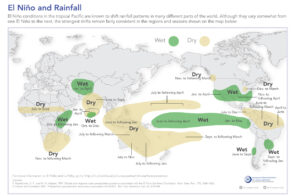This natural phenomenon is among the five strongest in the history of observations, noted the World Meteorological Organization.
GENEVA, March 5. /TASS/. Known for its warming effect, the natural phenomenon El Niño will continue to influence the climate in the coming months, despite its gradual weakening, leading to above-normal temperatures between March and May. This forecast was made by the World Meteorological Organization (WMO), a specialized agency of the UN.
The natural El Niño phenomenon of 2023-2024 “was among the five strongest in the entire history of observations,” the WMO noted. “It is now gradually weakening, but will continue to influence the global climate in the coming months, increasing the heat trapped by greenhouse gases,” the organization explained, adding that between March and May, “temperatures are forecast above normal for almost all land areas.”
There is a 60% chance that El Niño will persist from March to May. The WMO recalled that the phenomenon occurs on average every two to seven years and usually lasts from 9 to 12 months. It is “a natural climate pattern associated with ocean surface warming in the central and eastern tropical Pacific Ocean,” which influences weather in different areas of the world.
“Each month since June 2023 has set a new monthly temperature record, making 2023 the warmest year on record by a significant margin. El Niño has contributed to these record temperatures, but the main culprit is undoubtedly heat-trapping greenhouse gases “said WMO Secretary-General Celeste Saulo. She recalled that “sea surface temperatures in January 2024 were the highest on record for January.” According to her, “this is alarming and cannot be explained by El Niño alone.”
Typical rainfall patterns during El Nino events – IRI Data Library Maprooms

El Nino events are typically associated with increased rainfall in southern South America, the southern United States, the Horn of Africa, and central Asia. In contrast, El Niño can cause severe drought in Australia, Indonesia, parts of southern Asia, Central America and northern South America. During the boreal summer, warm water from El Niño can fuel hurricanes in the central and eastern Pacific while preventing hurricanes from forming in the Atlantic Basin. Typically, El Niño has the opposite effect of the recent La Niña, which ended earlier in 2023.
https://tass.ru/mezhdunarodnaya-panorama/20163151
https://meteoinfo.ru/novosti/99-pogoda-v-mire/19393-vsemirnaya-meteorologicheskaya-organizatsiya-obyavlyaet-o-nastuplenii-uslovij-el-nino

